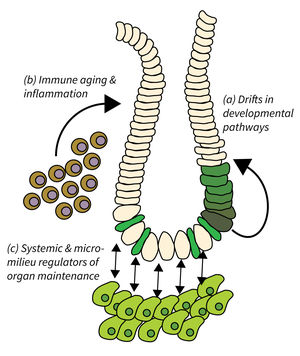Subarea 2: Regeneration and Homeostasis of Organs in Aging
The main goal of Subarea 2 is to identify cellular and molecular pathways used to ensure effective organ maintenance and repair, and to unravel the mechanisms of their deterioration during aging. While stem cells are important for organ homeostasis, this Subarea does not per se directly addresses stem cell aging but rather focusses on the following focus areas:
- Drifts in developmental pathways limiting organ maintenance in aging,
- Immune aging and inflammation, and
- Systemic and micro-milieu regulators of organ maintenance, regeneration, and disease development.
Research focus of Subarea 2
Organ maintenance is regulated by local and systemic factors, which are subject to aging-associated changes. Research of Subarea 2 focuses on the following research areas: a) Genetic and epigenetic modulation of developmental pathways has been shown to contribute to progressive aging and disease. It is critical to delineate mechanisms and consequences of aging-associated drifts to better understand organ maintenance during aging. b) Immunoaging and chronic inflammation elicits negative effects through reduced immune surveillance and aberrant organ repair and maintenance; all of which contributes to the evolution of organ pathologies and diseases during organismal aging. c) Furthermore, aging-associated alterations in systemic and extracellular factors derived from metabolic changes, microbiota alterations, chronic inflammation, senescent, or damaged cells might impinge on disease development and tumor initiation.
Publications
(since 2016)
2019
- Pharmacological reactivation of MYC-dependent apoptosis induces susceptibility to anti-PD-1 immunotherapy.
Haikala HM, Anttila JM, Marques E, Raatikainen T, Ilander M, Hakanen H, Ala-Hongisto H, Savelius M, Balboa D, Von Eyss B, Eskelinen V, Munne P, Nieminen AI, Otonkoski T, Schüler J, Laajala TD, Aittokallio T, Sihto H, Mattson J, Heikkilä P, Leidenius M, Joensuu H, Mustjoki S, Kovanen P, Eilers M, Leverson JD, Klefström J
Nat Commun 2019, 10(1), 620 - Publisher Correction: Pharmacological reactivation of MYC-dependent apoptosis induces susceptibility to anti-PD-1 immunotherapy.
Haikala HM, Anttila JM, Marques E, Raatikainen T, Ilander M, Hakanen H, Ala-Hongisto H, Savelius M, Balboa D, Von Eyss B, Eskelinen V, Munne P, Nieminen AI, Otonkoski T, Schüler J, Laajala TD, Aittokallio T, Sihto H, Mattson J, Heikkilä P, Leidenius M, Joensuu H, Mustjoki S, Kovanen P, Eilers M, Leverson JD, Klefström J
Nat Commun 2019, 10(1), 932 - Differential effects of hydrogen peroxide (H2 O2) treatment on epitope recognition in western blotting.
Han S, Cui Y, Helbing DL
Anal Biochem 2019, 586, 113417 - Age effect on thyroid hormone brain response in male mice.
Kerp H, Engels K, Kramer F, Doycheva D, Sebastian Hönes G, Zwanziger D, Christian Moeller L, Heuer H, Führer D
Endocrine 2019, 66(3), 596-606 - The nuclear pore proteins Nup88/214 and T-ALL-associated NUP214 fusion proteins regulate Notch signaling.
Kindermann B, Valkova C, Krämer A, Perner B, Engelmann C, Behrendt L, Kritsch D, Jungnickel B, Kehlenbach RH, Oswald F, Englert C, Kaether C
J Biol Chem 2019, 294(31), 11741-50 - Alternative NF-κB signaling controls peripheral homeostasis and function of regulatory T cells.
Koliesnik IO, Andreas N, Thuy A, Sreekantapuram S, Haenold R, Weih F
Immunobiology 2019, 224(5), 687-96 - RNAi-Screening in Knochenbildenden Zellen.
Kroll T, Ahmad M, Ploubidou A, Tuckermann J
BIOspektrum 2019, 25, 523–526 - CD44 deletion suppresses atypia in the precancerous mouse testis.
Li* H, Shukla* S, Frappart L, Herrlich** P, Ploubidou** A
Mol Carcinog 2019, 58(5), 621-6 * equal contribution, ** co-corresponding authors - Constitutive activation of the alternative NF-κB pathway disturbs endochondral ossification.
Nakatomi C, Nakatomi M, Matsubara T, Komori T, Doi-Inoue T, Ishimaru N, Weih F, Iwamoto T, Matsuda M, Kokabu S, Jimi E
Bone 2019, 121, 29-41 - The Myb-MuvB Complex Is Required for YAP-Dependent Transcription of Mitotic Genes.
Pattschull G, Walz S, Gründl M, Schwab M, Rühl E, Baluapuri A, Cindric-Vranesic A, Kneitz S, Wolf E, Ade CP, Rosenwald A, von Eyss B, Gaubatz S
Cell Rep 2019, 27(12), 3533-3546.e7









